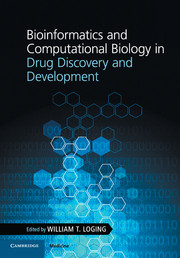Book contents
- Frontmatter
- Contents
- List of contributors
- Foreword: The future of drug discovery and healthcare
- Acknowledgments
- 1 The art and science of the drug discovery pipeline
- 2 Computational approaches to drug target identification
- 3 Understanding human disease knowledge through text mining
- 4 Integrating translational biomarkers into drug development
- 5 Computational phenotypic assessment of small molecules in drug discovery
- 6 Data visualization and the DDP process
- 7 Information visualization – important IT considerations
- 8 Example of computational biology at the new drug application (NDA) and regulatory approval stages
- 9 Clinical trial failures and drug repositioning
- Appendix I Additional knowledge-based analysis approaches
- Appendix II Open source tools and public data sources
- Index
- Plate section
- References
8 - Example of computational biology at the new drug application (NDA) and regulatory approval stages
Published online by Cambridge University Press: 05 February 2016
- Frontmatter
- Contents
- List of contributors
- Foreword: The future of drug discovery and healthcare
- Acknowledgments
- 1 The art and science of the drug discovery pipeline
- 2 Computational approaches to drug target identification
- 3 Understanding human disease knowledge through text mining
- 4 Integrating translational biomarkers into drug development
- 5 Computational phenotypic assessment of small molecules in drug discovery
- 6 Data visualization and the DDP process
- 7 Information visualization – important IT considerations
- 8 Example of computational biology at the new drug application (NDA) and regulatory approval stages
- 9 Clinical trial failures and drug repositioning
- Appendix I Additional knowledge-based analysis approaches
- Appendix II Open source tools and public data sources
- Index
- Plate section
- References
Summary
Target-based prejudices
In the early 2000s, a popular and clinically valuable class of drugs known as the nonsteroidal anti-inflammatory drug (NSAID) class was being used to treat osteoarthritis and acute pain conditions. Of the several chemical members of this class, rofecoxib was approved by the Food and Drug Administration (FDA) in May 1999, with Merck and Co. marketing it under the brand names Vioxx and Ceoxx. The drug recorded more than $2 billion a year with more than 75 million patients taking it worldwide.
In September 2004, rofecoxib was withdrawn from the market by Merck and Co. due to worries about its usage leading to increased risk of heart attack and stroke. This observation was noted in patients with long-term, high-dosage use. It has been estimated that these side effects led to the manifestation of heart disease in 100,000 cases.
The FDA intently scrutinized other NSAIDs and continued to do so. Several calls were made by concerned citizens and those affected by the rofecoxib side-effect case that the FDA needed to do more to insure public safety of post-approved drugs. Investigators began focusing on the target (known as COX-2), and it was hypothesized that the side effects observed were related directly to COX-2 inhibition. No concrete data have been observed about whether the cardiovascular effects were solely related to COX-2. However, the mindset was already created that if a side effect was observed through certain drug use then all mechanisms of physiological effects were termed again the “Vioxx effect.” This viewpoint – that all side effects and physiological effects were connected via a central target – impacted multiple other drug discovery projects as well, including the race to deliver the first CCR5 antagonists, which are a class of oral antiretroviral drugs designed to block HIV entry into cells via the CCR5 receptor. There were concerns that the novel mechanism of action of CCR5 antagonists was associated with potential risks of hepatotoxicity and malignancies, which might be adverse events that extend to all compounds in the class. The following work addressed such concerns by employing a wide range of computational approaches, utilizing pharmacology and human gene expression as well as clinical data to address these potential CCR5 antagonist class effects.
- Type
- Chapter
- Information
- Publisher: Cambridge University PressPrint publication year: 2016



